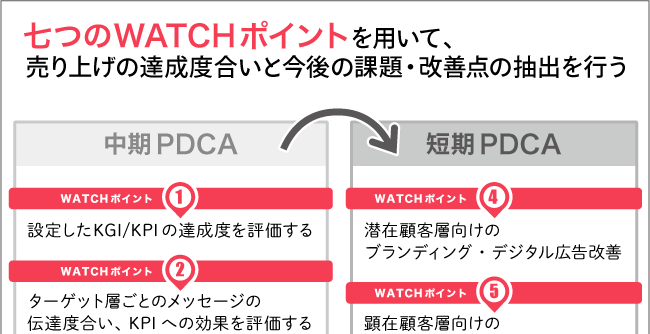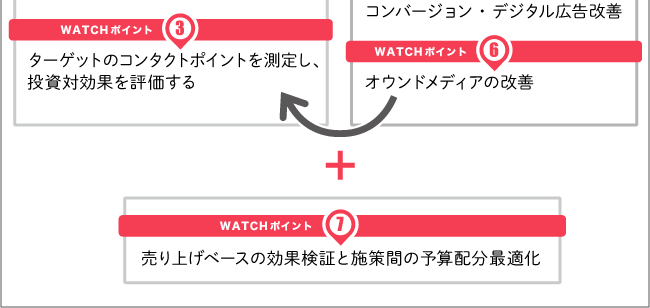
What troubles Ms. A, who works at a sporting goods store? (Illustration: Saki Kanai)
This series introduces the concept of People-Driven Marketing (PDM). The final theme is "Execution & PDCA."
The key lies in combining "Mid-Term PDCA" and "Short-Term PDCA," along with the "Seven WATCH Points" within them.

<Table of Contents>
~Ako's Story: Execution & PDCA Edition~
Ako, who works at the large sporting goods store "Sports People," has been tackling people-driven marketing ( i.e., people-centered, people-motivated ) using digital tools.
① Review shared employee targets and current challenges from a "people-centric" perspective. ( Objective )
②③ Estimate who customers are and their purchasing potential. ( Deep Dive, Person )
④ Analyze where opportunities exist in their daily lives to turn them into loyal customers. ( Journey )
⑤ Determine when and which media to use to deliver messages to potential customers identified through analysis and their opportunity points. ( Media & Promotion Design)
⑥ Then analyze what kind of message will yield what kind of effect. ( Creative & Activation)
Ms. A feels confident about the "strategies" developed so far, but she's concerned about whether she can effectively manage the PDCA cycle going forward.
"If we don't properly evaluate the data and each initiative, we'll just end up feeling vaguely satisfied..."
A-ko began "evaluating" the initiatives taken so far—
Seven WATCH Points to Avoid "Leaving Things Undone" and Connect to the Next Step
This is Matsuno from Dentsu Digital Inc. Drawing on my experience consulting on digital advertising and managing projects across various industries, I'll explain the "approach to executing initiatives" and the "PDCA methodology" within PDM.
Unlike the era when mass advertising alone drove sales, sustaining sales of products and services now requires integrating various initiatives in a complex and organic way.
Regarding how effective these approaches are, various digital data and research methods exist. It's no exaggeration to say that most of this can be visualized if you're willing to do so.
- How many of the targeted individuals were actually moved?
- Why did they take action?
- "Which data was used and how was it checked" to determine this?
- What is the next "challenge" to solve?
PDM consolidates these checkpoints into the "Seven WATCH Points" within both mid-term and short-term PDCA cycles. (Figure 1)


Figure 1: Seven WATCH Points in PDM
■WATCH Points 1–3 to Monitor in Mid-Term PDCA (Quarterly to Semi-Annual)
Regularly evaluate how the KGI/KPI set in the Objective changed and whether it was achieved through various "actions," utilizing awareness data and behavioral data.
The "mid-term" PDCA cycle is generally best conducted over a quarterly (3-month) to semi-annual (6-month) period.
【WATCH Point 1】
Evaluate the achievement level of KPIs at each stage of the anticipated funnel. Identify areas with poor progress = areas requiring improvement.
【WATCH Point 2】
Drill down further to check which specific targets or creatives significantly impacted KPIs (both positively and negatively).
【WATCH Point 3】
Compare the actual sequence of touchpoints experienced by the "people" who took action against the originally planned customer journey.
■Short-Term PDCA (Daily to Monthly) WATCH Points 4–6
For digitally measurable metrics, shorter PDCA cycles are possible.
These cycles of evaluation and improvement are conducted consistently on a "weekly" or "monthly" basis. Additionally, for scenarios like concentrated budget allocation in digital advertising, improvements are made on a "daily" basis.
【WATCH Point 4】
For digital initiatives targeting individuals with potential demand (like video ads or digital ads aimed at reach), set appropriate KPIs using either behavioral metrics, psychological metrics, or a combination of both. Run PDCA cycles to build brand awareness among this potential audience.
【WATCH Point 5】
For digital initiatives targeting individuals with explicit demand (e.g., search ads or targeted display ads), appropriately set the "conversion point" as the KPI. Maximize effectiveness through high-speed PDCA operations.
【WATCH Point 6】
Analyze the movements of "people" who have entered your owned media (company website) using data from page-specific PVs and heatmaps in access analysis tools.
You can analyze:
Using this data as a starting point, we identify areas on the website that aren't functioning as intended—the bottlenecks—and clarify the direction for improving the website and landing pages.
■Overall WATCH Point 7
We implement a comprehensive PDCA cycle that incorporates both medium-term and short-term perspectives.
【WATCH Point 7】
Optimize budget allocation across marketing initiatives to maximize ROI, factoring in external variables like day-of-the-week effects.
Combining mid-term and short-term PDCA cycles clarifies both "campaign effectiveness" and "next challenges." This prevents ending marketing & promotion with a vague "Overall ad effectiveness improved, so that's good," creating a cycle that avoids "leaving things unfinished." Consequently, you can focus on higher-ROI initiatives.
Design Execution to "Properly Execute PDCA"
Design and implement the initiatives themselves (Execution) with a focus on making PDCA easy to cycle from the start.
For example, suppose you're considering shifting part of the budget previously allocated to "flyers" toward initiatives that expose audiences to digital ads. This "flyer digitization" initiative involves numerous elements that must be decided.
【Execution: What about the implementation phase?】
"Which platform's target audience data should we use for delivery?"
"Which geographic segments should we target for delivery?"
【PDCA: How about effect verification?】
"Should we measure effectiveness with surveys? Or should we introduce a behavioral data measurement solution using location information to gauge effectiveness?"
"Over what time span should we observe the effects?"
Digital advertising campaigns become difficult to evaluate if the target audience is either too narrow or too broad, making it hard to determine if the intended "people" took meaningful action. This aspect of design truly tests the planner's skill.
Note that even if delivery design or execution doesn't go smoothly, the campaign isn't necessarily a "failure." In this era where performance data can be measured across offline and online channels, even if the expected results aren't achieved, that data can be treated as valuable insights and know-how.
Let's outline the elements to review when the expected results aren't achieved.
- Target (Who)
- Creative (What)
- Budget allocation timing (When)
- Synergy of contact points (Where)
- Ad Volume (How)
In summary, even for campaign-based advertising, it's crucial to commit to accumulating data over the medium to long term and engage in PDCA on an "Always On" basis. It's also vital to advance design and execution while keeping in mind "at what granularity," "over what timeframe," and "which target metrics" to pursue as you continuously implement measures.
Finally, return to the Objective
To quantitatively evaluate how the set KPIs changed due to various "tactics," Ako utilized surveys of ad recipients and location-based store visit measurement solutions. She also analyzed the correlation between offline and online initiatives linked to sales data.
The evaluation results revealed the following achievements and challenges:
・Successfully expanded awareness of "Sports People" among the targeted audience and increased the number of visitors to the store
・However, the conversion rate from store visits to actual product purchases did not significantly increase
Ms. A was able to quantitatively determine whether previous initiatives had altered the structure of the marketing funnel initially set as the Objective. By continuing to implement effective PDCA cycles, it seems likely that Sports People can continue to grow.
―As astute readers may have noticed in the above solution section, PDM has a next step beyond "Execution & PDCA."
That step is the Objective covered in Part 2. In other words, the "mid-to-long-term PDCA within PDM" encompasses checking whether the numbers in the marketing funnel set by the Objective have changed and then determining the next "action plan."
For sustainable business growth, PDM never truly ends. Only by executing the seven phases of PDM as a continuous flow and using them to "look at people" can we achieve lasting business growth.
Thank you for reading to the end.









